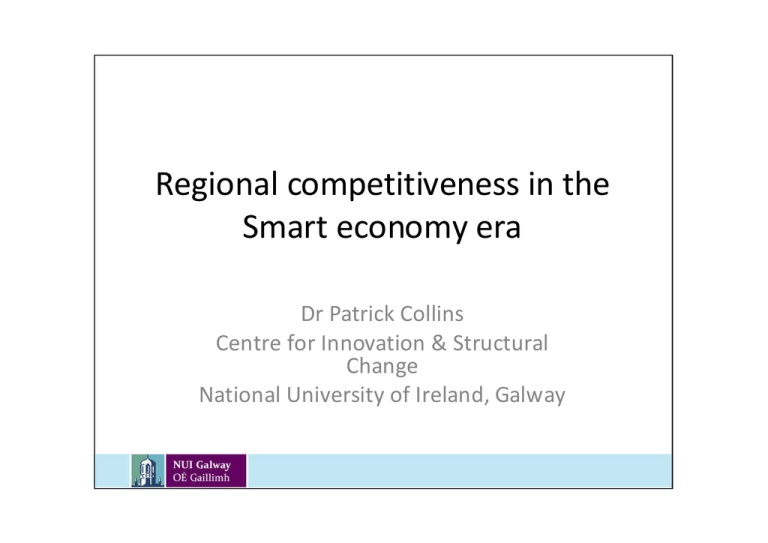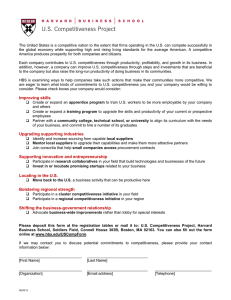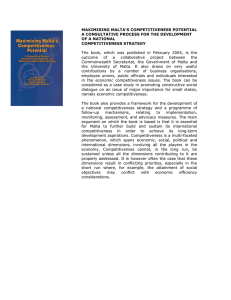Regional competitiveness in the Smart economy era Dr Patrick Collins
advertisement

Regional competitiveness in the Smart economy era Dr Patrick Collins Centre for Innovation & Structural Change National University of Ireland, Galway Competitiveness • ‘is a comparative concept of the ability and performance of a firm, sub-sector or country to sell and supply goods and/or services in a given market’. • is dynamic, in constant flux – ‘to be competitive today, does not mean you will be competitive tomorrow’ • => something of a moving target and difficult to quantify. Firm Competitiveness Doesn’t stop us! • Resource based view • Land, labour, capital etc. • Monotonicity – more you have, the more competitive you become? • The more of the rarer resources you have, the more competitive you become. Firm Competitiveness Replicable • Land • Physical labour • Equipment (significant) • Access to Capital • Codified knowledge Non-replicable • Tacit Knowledge • Social relations / ties / capital • Reputation • Brand Firm Competitiveness Warner Bros. MGM Studios Miller and Shamsie (1996) Firm Competitiveness Warner Bros. MGM Studios Victor Fleming Sydney Howard Shared Experience Social Capital Reputation Support Structures Firm Competitiveness Creative Apple iPod Firm Competitiveness Creative Apple iPod Pla tforms (i Tunes) Support s tructures Indus try Rela tions hips Media , Bra ndi ng, Social media , hype, experience, cool Firm Competitiveness • The tangible is only a starting point – • Increasingly, competition is taking place over the intangible. That is how firms differentiate themselves and offer unique experiences. Territorial Competitiveness • Resource based view of the region… • Stock of assets, topography, stratigraphy, population, urbanisation, etc. • Economic metrics Territorial Competitiveness • • • • • • Replicable Labour laws Industrial standards Education systems Taxes, tariffs, monetary and fiscal policies Innovation policies Smart economy policies • • • • • • • Non replicable Physical proximity Social environment Cultural environment Business environment Support systems Reputation / History Brand Territorial Competitiveness • A Rural Economy (manufacturing) • Infrastructure and access • Output, employment, FDI attraction (vis a vis S&E) • KIS sector €1billion • Medical Device Cluster (other tech clusters including software / gaming) • Strong potential for the creative economy (Doubling of the workforce) Innovation Audit May 2011 Territorial Competitiveness • Results from the Fifth Report on Economic, Social and Territorial Cohesion • = Average Territorial Competitiveness • Total Expenditure on R&D 98th • Patent applications to the EPO 98th • Regional Innovation Performance Index = ‘Average’ • Labour Productivity 120th • Broadband 146th Out of 260 regions in Europe Territorial Competitiveness • Population with tertiary Education 76th • Employment in high tech sectors 42nd • Regional Competitiveness ranking 130th (59.3 out of 100) Sum of the parts? • Renowned regionalist Micheal Storper defines Territorial Competitiveness as ‘the ability of an economy to attract and maintain firms with stable or rising market shares in an activity while maintaining standards of living for those who participate in it’ (1997: 20). Past 18 months • Testing period for the nation and the region. • Replete with ebbing fortunes in the jobs market. • European Restructuring Monitor and Media Searches… • Over 80 cases of restructuring in Ireland – 6,810 jobs lost, 12,212 jobs gained See Collins and Grimes (2011) 18 months restructuring BMW figures exclude national restructurings i.e. AIB, Aviva, Iceland (gains and losses roughly equal Types of jobs being lost (value) • Quick categorisation of Jobs along a hierarchy. Category Examples Low value manufacturing Assembly line production Low value Services Back office support, call centre, retail, High value manufacturing High end production, trained personnel, high value product High value services Customer support, HR, marketing, financial services High-end R&D and supra national remits Research and development, highly trained, EU HQ functions Types of jobs being lost (value) Types of jobs gained (value) Ownership of Jobs lost Ownership of jobs gained Competitiveness • ‘the ability of an economy to attract and maintain firms with stable or rising market shares’ Leading cities and regions will always attract people because they are seen as the places of opportunity (HBR, May 2010) People (Society) Attractive Place 64% of college educated 25 – 34 year olds said they looked for a job only after they’d chosen the city where they wanted to live. Competitive Place Firms ‘Glocalisation’ global economy is found in distinct enclaves (Dicken, 2000). Face-to-Face buzz (Ashiem, 2008) (Economy) Something fundamental is happening to our economy … jobs are following people (Landry, 2002) ‘This is exciting, what we are doing here is like LA versus the east coast’ ‘A cultural hotspot’ People (Society) Attractive Place EA games ‘right mix of infrastructure and international experience.’ Med Dev ‘A cluster of international significance’ Why here? It’s a quality of life issue more than anything else. 99 cultural facilities (Collins and Fahy, 2010) Competitive Place Firms (Economy) To employ 500 people from 70,000. We said over 500,000 are attracted to this city Competitiveness • The economy is evolving – there is an obvious move towards the experiential and the nontangible. • Applying old metrics of competitiveness (the tangible) will never let us know how to compete. • This is as true for regions as it is for firms Conclusion • Replicable policies attract replicable firms – • This is where competition actually exists as a zero sum game. (BMW can’t compete here) • The BMW region needs to focus on what it can offer that is unique. Boosting the systems of support (innovation) and cultivating / promoting its rich environment will act as a the key attraction for business growth and development. Thank you! • Email: P.Collins@nuigalway.ie • Web: http://www.nuigalway.ie/cisc/people/pcollins.html




